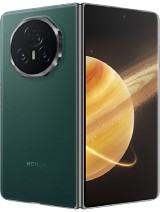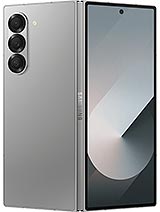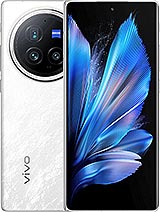Google Pixel 9 Pro Fold review
One of the largest displays on a phone - 8.0"
The Pixel 9 Pro Fold is marketed to have the biggest display on a smartphone. A quick research shows that this might indeed be the case. The Pixel 9 Pro Fold's inner, or main, display measures 8.0" in diagonal, has a boxy 1:1 aspect ratio and 2076 x 2152px resolution. Most other foldables have a wider aspect ratio, but only a little.
The display also uses an LTPO OLED panel with 120Hz refresh rate and granular control over it. HDR content is supported, but stops at HDR10+, so no Dolby Vision.
And while we are on the subject of content, the 1:1 aspect ratio of the main display is far from ideal for watching videos. The standard 16:9 videos appear pretty small and about half of the screen is covered in black bars. That's not necessarily unique to the Pixel 9 Pro Fold, as most foldables have a similar aspect ratio. But the video size looks about the same compared to the cover screen. There's hardly any difference between video playback on the main and the cover screen.
The secondary, or cover, display has a 6.3-inch diagonal, 1080 x 2424px resolution and a more standard 20:9 aspect ratio. This is likely the reason why the handset feels like a normal smartphone when folded. Essentially, the Pixel 9 Pro Fold is a chunkier version of the Pixel 9 when folded.
The cover display is a normal OLED with 120Hz refresh rate and regular HDR support.
This all sounds good on paper, but both displays' bezels are a bit thick. Pixel phones and thick bezels- name a more iconic duo.
When it comes to actual performance, though, both screens are excellent. In manual mode, the inner and cover displays scored 1,113 and 1,256 nits, respectively, while in auto mode, those values rose to 2,049 and 2,172 nits. That's very impressive for both panels and ensures an extra comfortable viewing experience outdoors. In fact, the Pixel 9 Pro Fold's displays are one of the brightest we've ever measured, similar to the Pixel 9 Pro XL.
Moreover, the uniform brightness ensures that the level of brightness is matched across both screens. Whatever brightness percentage you choose will be valid for both screens.
Refresh rate
Since the cover display is just a regular OLED, it will dial down from 120Hz to 60Hz when the phone is idle or showing static content. On the other hand, the inner LTPO OLED screen has one of the most sophisticated refresh rate controls we've seen.
The panel will often dial down to just 1Hz when not in use and won't boost back to 120Hz even when touching the screen. Something has to move, or you need to start interacting with the content on the screen for it to go back to 120Hz. This is a new kind of behavior we haven't noticed before. This ought to save some battery life.
Moreover, the system will recognize the frame rate of various YouTube videos and will match with an appropriate refresh rate - 24, 30 and 60Hz.
Battery life
The Pixel 9 Pro Fold features a 4,650 mAh battery, which is slightly more than the Galaxy Z Fold6 but less than other rivals in the segment. Still, the smartphone offers about the average you'd expect from a foldable.
The Active Use Score of 11:54 hours puts it above the Z Fold6 and the Honor Magic V3, but it's below the vivo X Fold3 Pro's result. Looking at each score individually, Google's foldable shows above-average performance in the web browsing test and decent video playback runtime.
The Pixel 9 Pro Fold is average when folded as well. Although the video playback runtime is a bit lower, the gaming scenario is curiously close to the web browsing's runtime.
Charging speed
The Pixel 9 Pro Fold's retail box doesn't ship with a charger, but the phone supports up to 21W over the Power Delivery 3.0 standard, so plenty of chargers on the market would be compatible with the Fold.
Sadly, Google's foldable is far behind the pack when it comes to charging speed. A 30-minute charging won't get you halfway there even, whereas a full charge takes more than hour and a half. That's even slower than the Galaxy Z Fold6, which is no speedster either.
Wireless charging is also available, but the phone reportedly can't charge using the Pixel stand and the supported charging speed is pretty slow too.
Speakers
The Pixel 9 Pro Fold features a set of two full-fledged speakers. They are well-balanced and are pretty loud too. In fact, the Pixel is the only foldable from the bunch to have a "Very Good" loudness score. It achieved -24.1 LUFS and has a significant lead over its direct rivals.
Sound quality is also pretty good, at least compared to the Magic V3 and the X Fold3 Pro. It has pronounced highs and mids with excellent vocals. However, the Galaxy Z Fold6 may appeal to most since it has deeper bass and overall warmer sound. The vocals aren't as clear as on the Pixel, though.
Use the Playback controls to listen to the phone sample recordings (best use headphones). We measure the average loudness of the speakers in LUFS. A lower absolute value means a louder sound. A look at the frequency response chart will tell you how far off the ideal "0db" flat line is the reproduction of the bass, treble, and mid frequencies. You can add more phones to compare how they differ. The scores and ratings are not comparable with our older loudspeaker test. Learn more about how we test here.
Reader comments
- Silent Productions
- 26 Jan 2025
- IbJ
The camera blows the fold out of the water, but then again most people are drawn to over saturated images where Samsung gets you every time. The pixel is far better and if you actually edit the photos to your liking, produces an overall much better i...
- VICKIE
- 06 Dec 2024
- fuI
I am disappointed with the Pixel 7a battery. I purchased my Pixel 7a on September 2, 2023, and just one year later, the battery stopped working. I kindly request that Google establish an official shop in Ghana so we can purchase phones, batteri...
- Anonymous
- 12 Nov 2024
- HXW
Is there actually AF on the selfie cams? Cause I'm fairly sure there isn't.





